Florida Southern Railway
The Florida Southern Railway (later known as the Florida Southern Railroad) was a railroad that operated in Florida in the late 1800s. It was one of Florida's three notable narrow gauge railway when it was built along with the South Florida Railroad and the Orange Belt Railway. The Florida Southern was originally chartered to run from Lake City south through central Florida to Charlotte Harbor.[1] However, with the influence of Henry B. Plant, it operated with two discontinuous segments that would be part of the Plant System, which would later become part of the Atlantic Coast Line Railroad.[2]

Interactive map of Florida Southern Railway lines (red). The South Florida Railroad's Pemberton Ferry Branch (blue) connected the two segments. Extension to Fort Myers is also shown (dark red). | |
 | |
| Overview | |
|---|---|
| Locale | Florida |
| Dates of operation | 1881–1903 |
| Successor | Atlantic Coast Line Railroad |
| Technical | |
| Track gauge | 4 ft 8 1⁄2 in (1,435 mm) standard gauge |
| Previous gauge | originally 3 ft (914 mm) gauge |
History
Original Charter
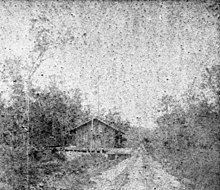
The Florida Southern Railway was first chartered as the Gainesville, Ocala, and Charlotte Harbor Railroad in 1879, with a planned route from Lake City to Charlotte Harbor with a branch to Palatka to connect with steamboats on the St. Johns River. The name was then changed to the Florida Southern Railway in 1881.[1]
The first segment of the line opened on August 21, 1881 from Gainesville to Palatka. In Palatka, a roundhouse with a turntable was built as well as a wharf in the St. Johns River.[2]
The line was extended from Rochelle just south of Gainesville to Ocala by the end of 1881. Track from Gainesville to Ocala would be the main line and the track from Rochelle to Palatka would be the Palatka Branch. A branch to Micanopy was also included. By 1883, the southern end of the main line reached Leesburg, and construction began at the northern end to extended the line from Gainesville to Hague.[1]
Henry Plant’s involvement

In 1883, Henry B. Plant was in the midst of building his own system of railroads south from Du Pont, Georgia to Live Oak, Florida and south to Charlotte Harbor with plans to build in a similar path. Construction was underway on the Live Oak, Tampa and Charlotte Harbor Railroad when he learned of the Florida Southern's plans. Plant then sought to buy the Florida Southern but was unsuccessful. Despite this, he did manage to make a mutually beneficial agreement with the Florida Southern to avoid having two competing lines. In the agreement, Plant would not build the Live Oak, Tampa and Charlotte Harbor Railroad, past Gainesville. He bought the Florida Southern's unfinished line and charter north of Gainesville and completed it as part of his line.[3]
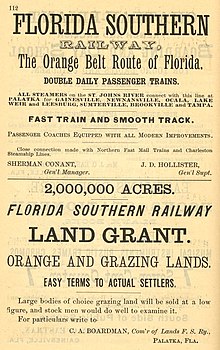
The Florida Southern would then operate the combined network from Gainesville south to Pemberton Ferry where it would connect with a branch of the South Florida Railroad, another railroad Plant was involved with. The South Florida Railroad's Pemberton Ferry branch would then operate from Pemberton Ferry south to Lakeland, where it would cross and briefly join the South Florida Railroad's main line, and then turn south to Bartow. In Bartow, the Florida Southern would resume and finish the route south to Charlotte Harbor.[2]
The Florida Southern Railway reached Leesburg by 1883, where it connected with the St. Johns and Lake Eustis Railway, which extended east towards Tavares, Altoona, and Astor. The Florida Southern later leased this branch line.[1]
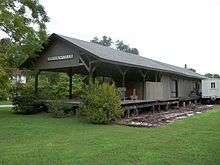
The Florida Southern Railway reached Pemberton Ferry (known today as Croom) by 1885 and would be extended west from there to Brooksville shortly after.[2]
Construction began on the southern segment of the line, known as the Charlotte Harbor Division, in September 1885 from Bartow along the Peace River (where large deposits of valuable phosphate was discovered in 1881) to Arcadia and Charlotte Harbor. The Charlotte Harbor Division was initially intended to terminate on the north side of Charlotte Harbor at a location known as Hickory Bluff (just southeast of Port Charlotte). However, just across the harbor from Hickory Bluff was a small town being planned by a man named Isaac Trabue.[4] Trabue owned waterfront property and successfully convinced the Florida Southern to instead run the railroad to his planned town, which would become Punta Gorda. Trabue offered half of his land holdings to the Florida Southern in exchange for the railroad coming to his town.[5] Surveying work to determine the route for the Charlotte Harbor Division was accomplished by local civil engineer Albert W. Gilchrist, who would later serve as Florida's 20th governor. The Charlotte Harbor Division was completed with its first train to Punta Gorda (initially known as Trabue) on July 24, 1886.[5] Plant would go on to open a hotel in Punta Gorda in 1896.[6] This hotel, the Hotel Punta Gorda, would later be owned by Barron Collier, the namesake of nearby Collier County.[7]
The Florida Southern Railway went into receivership in 1890, though the Charlotte Harbor Division was operated independently through the receivership. It came out of receivership in 1892 and was reorganized as the Florida Southern Railroad. The Charlotte Harbor Division was converted to standard gauge in 1892.[1]
The Florida Southern was fully absorbed into the Plant System in 1896, which was then sold to the Atlantic Coast Line Railroad in 1902. The Atlantic Coast Line continued to operate the Florida Southern lines for and also rebuilt many of the original wooden stations along the lines with brick stations up until the 1920s.[8][9]
The Atlantic Coast Line became the Seaboard Coast Line Railroad in 1967 after merging with their former rival, the Seaboard Air Line Railroad. In 1980, the Seaboard Coast Line's parent company merged with the Chessie System, creating the CSX Corporation. The CSX Corporation initially operated the Chessie and Seaboard Systems separately until 1986, when they were merged into CSX Transportation.
Lines
Northern lines
The Florida Southern's northern lines began along Main Street in Gainesville, where it continued south from Henry Plant's Live Oak, Tampa and Charlotte Harbor Railroad. The line headed southeast from Gainesville to Rochelle, where it split with the Palatka Branch heading east to Palatka via Hawthorne and Interlachen. The main line continued south from Rochelle to Ocala. A short branch just south of Rochelle also split from the main line to the small town of Micanopy. From Ocala, the main line continued south-southeast to Leesburg before turning southwest to Center Hill, Pemberton Ferry, and Brooksville. The line connected with the South Florida Railroad's Pemberton Ferry Branch at Pemberton Ferry, which connected the line with the Florida Southern's Charlotte Harbor Division.
The Florida Southern's northern segment would play an important role in the Atlantic Coast Line's network after it was acquired in 1902. The main route would become the Atlantic Coast Line's High Springs–Croom Line with track from Croom (the later name of Pemberton Ferry) to Brooksville becoming the Brooksville Branch. The line served as an alternate route to the Atlantic Coast Line's main line (the former Jacksonville, Tampa and Key West Railway and South Florida Railroad main line).[1] The Atlantic Coast Line's West Coast Champion used the line for much of its history on its run from Jacksonville to St. Petersburg. In 1948, the Atlantic Coast Line rerouted the line in central Gainesville from Main Street to instead run along 6th Street, where they built a new depot. This rerouted segment used the former right of way of the Gainesville and Gulf Railroad.[10] By 1949, the West Coast Champion and a local passenger train ran the line daily along with freight service six days a week.[11]
In the Seaboard Coast Line era, the former Florida Southern's northern routes operated as the Ocala Subdivision and Palatka Subdivision (east of Rochelle). A local passenger train would continue to use the line up until 1971 when Amtrak took over the Seaboard Coast Line's passenger operations.[12][13]
By 1982, the former Florida Southern's track from Palatka to Edgar was abandoned, and track south of Micanopy Junction was broken up into segments.[14] These abandonments were mostly due to the line's proximity to CSX's S Line (the former Seaboard Air Line main line).[3] By 1989, track was abandoned from Gainesville to Hawthorne.[15]
Charlotte Harbor Division
The Charlotte Harbor Division began at the south end of the South Florida Railroad's Pemberton Ferry Branch in Bartow. From Bartow, it continued south roughly paralleling the Peace River through Fort Meade, Wauchula, and Arcadia before coming to an end at Punta Gorda along Charlotte Harbor. The terminus was initially located at the end of a long pier into Charlotte Harbor known as Long Dock just west of downtown Punta Gorda where connection to steamships could be made.[16]
One of the Coast Line's first orders of business regarding the Plant System after acquiring it was extending the Florida Southern's Charlotte Harbor Division south to Fort Myers. Despite also owning a hotel in Fort Myers, Plant had been reluctant to have the line continue to Fort Myers (which had already been established as a city when the line was built unlike Punta Gorda) under his ownership as Charlotte Harbor was his ultimate goal.[6] However, the Atlantic Coast Line saw greater opportunity. The Atlantic Coast Line would complete the extension to Fort Myers in 1904. The Atlantic Coast Line would designate this line as the Lakeland–Fort Myers Line (X Line).[11] The Atlantic Coast Line later used the dormant charter of the unbuilt Fort Myers Southern Railroad to further extended the line to Naples and Collier City (on Marco Island) during the Florida land boom of the 1920s.[5][2] The Atlantic Coast Line's Gulf Coast Special and West Coast Champion were notable passenger services to operate on the line from Bartow to Naples.[17] By 1949, the Atlantic Coast Line operated a daily local passenger train and a daily freight train along the line from Bartow to Fort Myers with mixed train service continuing south to Naples.[11]
In the Seaboard Coast Line era, the line operated as the Fort Myers Subdivision.[13] Passenger service on the line ended in 1971 after Amtrak took over the Seaboard Coast Line's passenger operations. Track from Bowling Green to Arcadia was removed in the late 1980s. Track south of Arcadia now connects to the rest of CSX's network via the former Charlotte Harbor and Northern Railway.[5]
Current conditions
Some segments of the Florida Southern today remain active today and some abandoned segments have since become rail trails.
The Gainesville-Hawthorne State Trail runs on the Florida Southern's former right of way between those two locations. From Hawthorne east to Edgar, the line is still in service and is now CSX's Edgar Spur (which now connects to CSX's S Line).
Another active segment remains in Northern Florida between Lowell, Ocala, and Candler. This segment is operated by the Florida Northern Railroad, a shortline run by Regional Rail, LLC, which crosses the S Line in Ocala.[18]
A short segment was still active near Leesburg which had been operated by the Florida Midland Railroad (another Pinsly company) since 1987 (this line also used former Seaboard track from Wildwood to Leesburg). This line was abandoned in late 2000.[19]
The Good Neighbor Trail runs on the former right of way between Croom and Brooksville.
Two segments of the Charlotte Harbor Division are also still in service. Trackage from Homeland (just south of Bartow) to Bowling Green is now the southernmost segment of CSX's Valrico Subdivision, which continues to carry phosphate traffic. From Arcadia south to Punta Gorda, the line is operated by Seminole Gulf Railway (who also operates the extension to Fort Myers). Some of the original right of way through downtown Punta Gorda west of US 41 is now the Punta Gorda Linear Park.
Much of U.S. Route 17 was built alongside the Charlotte Harbor Division and the highway has largely been widened into the abandoned right of way between Bowling Green and Arcadia.[20]
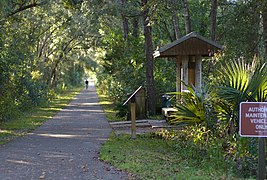 The Gainesville-Hawthorne Trail was built along the former right of way between the two locations
The Gainesville-Hawthorne Trail was built along the former right of way between the two locations CSX train passing the historic Fort Meade Depot on the former Charlotte Harbor Division
CSX train passing the historic Fort Meade Depot on the former Charlotte Harbor Division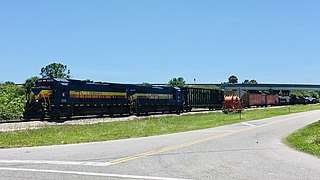 Seminole Gulf Railway's Desoto Turn on the former Charlotte Harbor Division near Punta Gorda
Seminole Gulf Railway's Desoto Turn on the former Charlotte Harbor Division near Punta Gorda
Station listing
| Milepost | City/Location | Station[21][11][13][22] | Opening date | Connections and notes | |
|---|---|---|---|---|---|
|
Gainesville to Brooksville | |||||
| ARB 740.1 | Gainesville | Gainesville | 1881 | junction with:
| |
| Oliver Park | |||||
| ARB 749.5 AS 737.5 |
Rochelle | junction with Palatka Branch | |||
| AS 743.1 | Micanopy Junction | junction with Micanopy Branch | |||
| Micanopy | located on Micanopy Branch | ||||
| AS 745.7 | Evinston | ||||
| Boardman | |||||
| Lochbie | |||||
| Oak Lawn | |||||
| AS 753.7 | Reddick | Reddick | |||
| Martin | |||||
| AS 768.3 | Ocala | Ocala | junction with:
| ||
| Welshton | |||||
| AS 781.2 | Candler | ||||
| AS 785.2 | Ocklawaha | ||||
| AS 787.7 | East Lake | ||||
| AS 790.2 | Weirsdale | South Lake Weir | |||
| Conant | |||||
| AS 795.0 | Lady Lake | Lady Lake | |||
| AS 799.1 | Fruitland Park | Fruitland Park | |||
| AS 802.7 | Leesburg | Leesburg | 1883 | junction with:
| |
| AS 808.3 | Okahumpka | ||||
| AS 816.9 | Center Hill | Center Hill | junction with Seaboard Air Line Railroad Miami Subdivision | ||
| AS 833.1 | Pemberton Ferry | 1885 | later renamed Croom junction with South Florida Railroad Pemberton Ferry Branch (ACL) | ||
| AS 843.1 | Brooksville | Brooksville | station still standing and is now a museum junction with Tampa Northern Railroad (SAL) | ||
|
Palatka Branch | |||||
| AS 698.6 | Palatka | Palatka | 1881 | junction with: connections to steamships | |
| AS 703.0 | Francis | ||||
| AS 710.5 | Hollister | ||||
| Lanarks | |||||
| Mannville | |||||
| AS 715.8 | Interlachen | Interlachen | |||
| Keuka | |||||
| AS 719.9 | Edgar | ||||
| Clark's Mill | |||||
| Johnson | |||||
| Cooper's Mill | |||||
| McMeekin | |||||
| Cone's Crossing | |||||
| Colegrove | |||||
| AS 728.7 | Hawthorne | Hawthorne | junction with Florida Central and Peninsular Railroad Tampa Division (SAL) | ||
| Continue's Mill | |||||
| AS 733.3 | Grove Park | ||||
| AS 737.5 | Rochelle | Rochelle | junction with Gainesville to Brooksville line | ||
|
Charlotte Harbor Division | |||||
| AX 864.0 | Bartow | Bartow | junction with:
| ||
| AX 870.2 | Homeland | ||||
| AX 875.2 | Fort Meade | Fort Meade | station rebuilt in 1914 | ||
| AX 882.7 | Bowling Green | Bowling Green | station rebuilt in 1925 | ||
| AX 889.3 | Wauchula | Wauchula | station rebuilt in 1914 | ||
| AX 893.4 | Zolfo Springs | Zolfo Springs | |||
| AX 896.3 | Moffitt | ||||
| Charlie Apopka | |||||
| AX 903.8 | Gardner | ||||
| AX 907.1 | Brownville | ||||
| AX 913.2 | Arcadia | Arcadia | 1886 | station rebuilt in 1911 junction with: | |
| AX 917.2 | Nocatee | ||||
| AX 923.9 | Fort Ogden | ||||
| AX 933.5 | Cleveland | ||||
| AX 937.2 | Punta Gorda | Punta Gorda | southernmost point of the Plant System originally known as Trabue station rebuilt in 1897 and 1928 connections to steamships | ||
|
Extension to Fort Myers | |||||
| AX 941.3 | Acline | 1904 | |||
| AX 949.3 | Gilchrist | junction with Seaboard Air Line Railroad Fort Myers Subdivision | |||
| Slater | |||||
| AX 957.0 | North Fort Myers | Samville | later renamed Bayshore | ||
| AX 961.2 | Tice | ||||
| AX 964.8 | Fort Myers | Fort Myers | continues as the Fort Myers Southern Railroad (ACL) | ||
References
- Hensley, Donald. "Florida Southern's Narrow Gauge Years 1879-1896". Tap Lines. Retrieved 6 August 2017.
- Turner, Gregg (2003). A Short History of Florida Railroads. Arcadia Publishing. ISBN 978-0-7385-2421-4.
- "When Trains First Came to Central Florida". Tampa Bay Trains. Retrieved 7 August 2017.
- O'Phelan, Ann M.; Shively, Scot (2009). Punta Gorda. Arcadia Publishing. Retrieved 3 March 2020.
- Turner, Gregg M. (December 1, 1999). Railroads of Southwest Florida. Images of America. Arcadia Publishing.
- "Current Exhibits". Henry B. Plant Museum. Retrieved 16 July 2020.
- "Hotel Punta Gorda". Charlotte County, Florida. Retrieved 16 July 2020.
- "Surviving Florida Railroad Stations" (PDF). American Rails. Retrieved 20 June 2020.
- Mulligan, Michael (2008). Railroad Depots of Central Florida. Arcadia Publishing. Retrieved 20 June 2020.
- "Gainesville's Railroads". Explore Historic Alachua County. Retrieved 6 August 2020.
- Atlantic Coast Line Railroad Southern Division Timetable (1949)
- Seaboard Coast Line Railroad Jacksonville Division Timetable (1969)]
- Seaboard Coast Line Railroad Jacksonville Division and Tampa Division Timetable (1977)
- Seaboard Coast Line Railroad Jacksonville Division and Tampa Division Timetable (1982)
- "Parcel: 19801-300-000". Alachua County Property Appraiser. Retrieved 2 November 2012.
- "The Long Dock Enabled Transit to Havana, New Orleans and Key West". The Punta Gorda History Center Blog. Retrieved 10 July 2020.
- Robinson, D.C. (11 September 2017). ACL, SAL and Southern: Passenger Timetables. Retrieved 15 July 2020.
- "Florida Central, Midland, and Northern Railroads". Pinsly Railroad Company. Retrieved 7 August 2017.
- Surface Transportation Board Decision Document
- "Abandoned Railroad Rights-of-way". Google. Retrieved 4 October 2018.
- "Florida Southern 1887 Timetable". Taplines. Retrieved 5 March 2020.
- "Florida Railroad: Passenger Stations & Stops" (PDF). Jim Fergusson's Railway and Tramway Station Lists. Retrieved 5 June 2020.